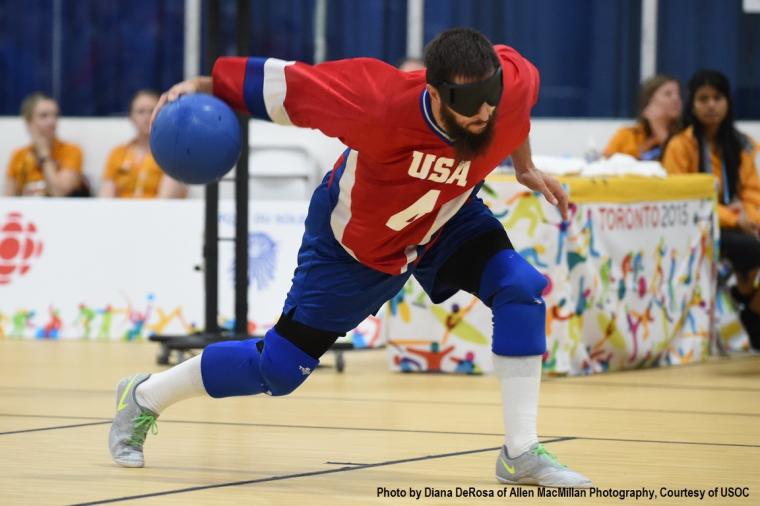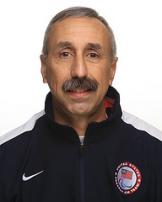
 USA Goalball
USA Goalball
United States Association of Blind Athletes
Goalball was introduced as a medal event at the 1976 Paralympic Games in Toronto after its success as a demonstration event at the Heidelberg 1972 Paralympic Games. However, the sport dates back to 1946 when it was created by Austrian Hanz Lorenzen and German Sett Reindle as a way to rehabilitate WWII veterans who had lost their vision. The sport is now played in 112 countries.
Men's and women's goalball teams have a roster of six at most international events but compete in teams of three. Unlike other team events that involve a ball, such as wheelchair basketball or wheelchair tennis, goalball is played only by visually impaired athletes. All players wear eye masks to equalize visual impairment among the athletes.
The U.S. national goalball teams and the day-to-day operations of the high performance program are overseen by the United States Association of Blind Athletes.
Sports Destination Management: It’s a Paralympic year; do you anticipate more people learning about goalball and becoming interested in playing it?
John Potts: We’re working hard every day to grow the sport of goalball. We’re involved not only locally and nationally in growing the game, but globally as well. Our challenge is to find people and make them aware of the sport and teach them how to play.
SDM: In some ways, the sport resembles team handball.
Potts: This sport does have a very loose kinship with team handball, and at the Olympic and Paralympic levels, we share the same venue. Team handball does not have a Paralympic counterpart so this is probably the closest to it.
SDM: Whereas wheelch

Potts: Exactly: This is a purely Paralympic sport; you won’t find anything like it anywhere else. A lot of people don’t realize that.
SDM: What types of facilities are needed for goalball?
Potts: The sport was originally designed to be played on a court the same size as a volleyball court, and that remains to this day. Generally, you’re using a gymnasium or an arena, but there are specific sensory elements. The lines of the court have string under them so that the players can feel them. The ball has bells in it so that players know where it is.
Something that makes the sport unique, however, is that we need a very quiet environment. The players need to hear the ball and be aware of where other athletes are. When we’re trying to host larger events where we need larger gyms, we look for places that have multiple gymnasiums so that we can run events simultaneously; however, we have to find gyms where you can’t hear what’s going on nearby. A curtain that drops down between two playing areas isn’t going to work since the sound comes right through. That’s really our biggest challenge – and that’s not just for games, it’s for practices. It’s tough for teams to find quiet places to practice because even if they can get space at a local arena or gym or community center, there is usually noise from other activities.
SDM: What else do you look for in a facility? In a host city?
Potts: There are challenges that people who are visually impaired face, that other athletes don’t. People with visual impairments can’t drive to a facility so  there has to be public transportation for them; they can’t just get a rental car and go where they need to go. If you are choosing a host city, you’re taking that into consideration as well. Apart from that, we need what everyone wants: infrastructure, reasonably priced hotels and restaurants, things that are close by so that people can get around easily.
there has to be public transportation for them; they can’t just get a rental car and go where they need to go. If you are choosing a host city, you’re taking that into consideration as well. Apart from that, we need what everyone wants: infrastructure, reasonably priced hotels and restaurants, things that are close by so that people can get around easily.
SDM: What other challenges does the sport face?
Potts: Expense is one – because we’re small, local teams don’t have a lot of opportunities to find others to compete against. Often, travel is needed, and as we said, that’s a challenge for many people. It’s also an expense, and many athletes are on disability so their income is limited. Also, it used to be that we could just use a gym or a community center, but now, if those facilities are rented out – if they’re available at all.
Currently, there is increased concern over legal liability so a lot of times, state legislation says someone has to be there to monitor what goes on in the gym. That means paying someone. There are a lot of challenges.
We have a core group of organizers that puts on tournaments for us. We’re all focused on keeping costs to a minimum so that money doesn’t be a barrier to access. The goal is to put on a quality event at a minimal cost, and we don’t tax our organizations to host for us.
In some ways, they’re the same as with any sport – finding athletes and keeping costs down – and in some ways, they’re specific challenges, like transportation and so forth. But those are the things we face every day. We’re lucky in that our referees (and you do need those) are volunteers, but we have to pay for their travel. Often, the sport is operating at a breakeven at best.
SDM: What surprises people the most about goalball when they see it for the first time?
 Potts: Something that surprises people is the intensity and speed of play – athletes are diving through the air and physically blocking the ball with their bodies, then hurling the ball straight back at their opponents’ goal. The accuracy and the speed make it easy to forget the athletes can’t see. Of course, they say a picture is worth a thousand words – if you’re sighted – so we encourage people to look it up on YouTube.
Potts: Something that surprises people is the intensity and speed of play – athletes are diving through the air and physically blocking the ball with their bodies, then hurling the ball straight back at their opponents’ goal. The accuracy and the speed make it easy to forget the athletes can’t see. Of course, they say a picture is worth a thousand words – if you’re sighted – so we encourage people to look it up on YouTube.
Editor’s Note: Check out this video from the finals of the 2014 ISBA World Goalball Challenge.
SDM: Goalball athletes aren’t easily intimidated, are they?
Potts: Our athletes are high achievers – they’re not sitting at home mired in misery. They’re out grasping life and making the most of it.

